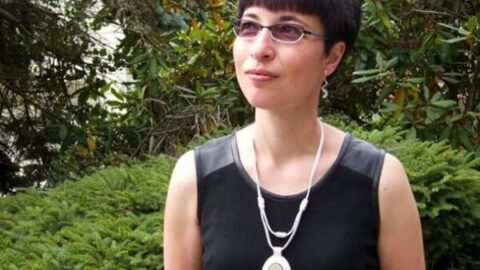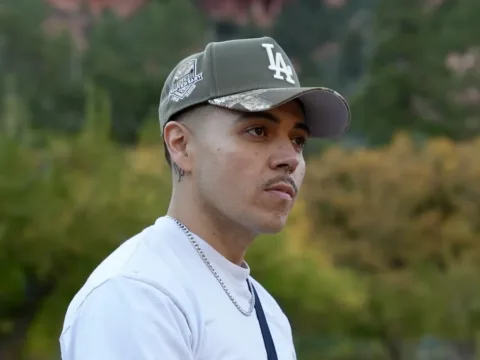A champion of contemporary and experimental music, Seattle-based scholar Elena Dubinets balances her own research with a busy schedule as an artistic advisor and festival presenter. The author of several publications, including Made in the USA: Music is What Sounds Around (on American experimental music) and an upcoming book on Russian contemporary composers, Dubinets is also the Vice President of Artistic Planning for the Seattle Symphony and artistic advisor for the Seattle Chamber Players (SCP). Known for their devotion to contemporary chamber music, SCP received the ASCAP/Chamber Music America Award for Adventurous Programming in 2004.
On October 25, Dubinets and SCP present a lecture-performance on music and new technologies as part of the 39th International Conference on Social Theory, Politics, and the Arts (STP&A), held at Seattle University. Dubinets’ paper, “Creating and Presenting Classical Music in the Era of New Technologies”, explores the interplay of music and technology in the context of compositional practices and concert presenting. I spoke with her about her upcoming talk and the many ways that technology influences today’s composers, performers, and audiences.
As a scholar of contemporary experimental and avant garde music, you’ve written about many different aspects of today’s composers and their work. What inspired you to take a closer look at new technologies and the role they play in the 21st century musical landscape? Could you share a few of your important discoveries and conclusions?
The cross-fertilization of classical music with technologies offers unprecedented opportunities to attract new audiences and enhance their music experiences. It also gives unique and indefinite tools to artists for expressing themselves. Now that informational boundaries no longer exist due to the explosion of digital connectivity, relationships between classical music and the rest of the world are changing rapidly, and musicians must embrace today’s technological realities in order to reaffirm classical music’s mission and sustainability.

Even the title of the conference at which my paper will be presented – Arts & Culture: Creating Community in a High Tech World – indicates the importance of this issue for our times. I am grateful to the International Conference of Social Theory, Politics and the Arts (STP&A), the most influential academic gathering in the field of arts management and cultural policy, for featuring a presentation about classical music on its program; our field certainly needs some attention!
The idea of this lecture came up when I was researching repertoire for the Seattle Chamber Players’ festival of high-tech music-making called Icebreaker VII: Open Source that will take place in March 2014. Its program will wholly consist of music by twenty-first century composers from around the world that embodies startling advances in the music-related areas of technology and communications. Underlining an exciting, coherent and complex dialogue between live music, electronics and film, this festival will embrace audiences in a single continuum of total perception, and such marriage of music and technology can help increase empathy and aesthetic appreciation of our art form in a vibrant and inclusive society of the future.
Your lecture will be accompanied by “musical illustrations” performed by the Seattle Chamber Players. The program features recent compositions by Vladimir Nikolaev, Michel van der Aa, Yannis Kyriakides, and Michael Beil. How do these works represent the interplay of music and technology to you? Do they reflect any specific trends in composition that are happening today?
These works utilize different technologies as both reactive and provocative ingredients seamlessly integrated into the live musical performances. Russian composer Vladimir Nikolaev grew up listening to Jimi Hendrix’s music which he knew via one of the rare American records (i.e. technology!) that made it to the USSR at the time. Nikolaev’s vnik-ton experience (which doesn’t include electronic components) reflects upon Jimi’s music, and such constant renewal of the music meaning is one of the most important driving cultural forces of our time. Dutch composer Michel van der Aa’s Memo is a curious example of how outdated technology can still influence music as the violinist is supposed to record himself on a portable cassette recorder and then play along with the recording. Greek composer Yannis Kyriakides’ Karaoke Etudes are designed as a participatory composition sampling iconic Pop classics with video-driven live interactions. German composer Michael Beil’s open source also positions the creation of music along the lines of audience engagement, using multiple interpretations of a classical aria found on YouTube to construct a new piece.
The message we receive from some of these new compositional strategies is that the arts cannot survive in a “container space” anymore; they must embrace a participatory culture pertinent to the latest technological developments. Five years ago, the Seattle Chamber Players performed in the differently constructed but also audience-engagement-oriented Cathedral Project by Bill Duckworth at one of our earlier Icebreaker festivals curated by Alex Ross and Kyle Gann. The participatory approach might be one of the most interesting trends that classical music culture is now trying to grasp in order to enhance involvement, and technologies can help with it.
In addition to your role as Artistic Advisor for the Seattle Chamber Players, you’re the Vice President of Artistic Planning for the Seattle Symphony. How are technological developments changing the way larger classical music organizations interface with repertoire, present concerts, and engage audiences? How do you and your colleagues at the Seattle Symphony incorporate technology into the mission of the orchestra?
Last season, implementing the vision of our music director Ludovic Morlot, we began presenting a new series of contemporary music called [untitled] (to reflect the sense of the unexpected) in Benaroya Hall’s beautiful grand lobby. Concerts begin at 10pm on Fridays, the musicians are placed among the audience members and patrons can walk around freely. We try to create a unique niche for performing challenging contemporary music by breaking down barriers of all types. To augment the impact, program notes and patrons’ comments on multiple social media platforms are projected onto the large screens spread around the lobby. This series proved to offer an enticing means to present highly sophisticated content without compromises to the presentational nature of music performances.
We offer many concerts that include multimedia on the main stage, from screening movies with live orchestra playing the soundtrack and to the Chicago Symphony’s Beyond the Score project. We have performed scores for orchestra and electronic components, including Gabriel Prokofiev’s amazing Concerto for Turntables and Orchestra. A more subtle utilization of technologies was demonstrated at the world premiere performances of John Luther Adams’ Become Ocean commissioned by the Seattle Symphony (we will be bringing this piece to Carnegie Hall in May 2014) that were accompanied by a rather innovative lighting design cued in the score.
Next season, we will premiere a very exciting commission from the incredible music inventor Trimpin, our composer in residence for the next three seasons (the position generously supported by New Music USA), who is creating a piece for chamber orchestra and sound sculptures which will require the conductor to communicate via an electronic device inserted in the music stand.
Thanks to the rise of hand-held computing devices like smartphones, tablets, and e-book readers, technology has become all the more ubiquitous in the past decade. Today, we can create complex beats with a smartphone app or access our entire sheet music library on a tablet. There’s no doubt that these devices have had a huge positive impact on composition and music-making, but are there any downsides to having so much technology constantly at our fingertips? What is gained and what is lost as the experience of creating, playing, and listening to music continues to evolve alongside changing technologies?
The captivating emotional investment into music can be achieved both via careful and receptive listening of an artists’ performance and through personal involvement that stimulates active interaction, be it twitting during performance or co-creating a music piece via open source technologies. People learn how to bring their own feelings into music via technologies, affecting the ways the music is now produced and heard. However, the core value of our art form hasn’t changed as it is still about the transformational magic of music and the emotional connection with times and memories that it can bring to people.
Let’s talk about the future. How do you think technology will inspire composition, music-making, and performance in the next decade? Are there any developments or emerging technologies that you find particularly exciting?
Composers will always look for new ways to express themselves and will keep exploring new technological tools. For instance, composers and engineers at DXARTS, Center for Digital Arts and Experimental Media at the University of Washington (a Seattle equivalent of the MIT Media Lab), are investigating new robotic technologies, and the Seattle Chamber Players is working on an exciting project with them. While I am not a prophet and not even an artist, I believe in the open source philosophy and I also see potential in Kinect-type technologies. But regardless of what kinds of technologies will be utilized in the future, it’s clear that they will keep heavily influencing our field and we have to be prepared for unprecedented developments both in the areas of music composition and audience engagement. Technologies can empower us to observe, explore and interact with music both as empathic spectators and immersed creators. They can magnify the impact of music and enhance the connection between the musicians and the audiences.
























